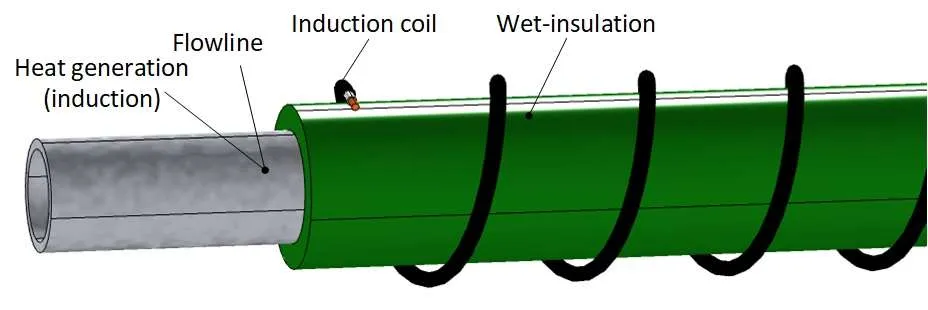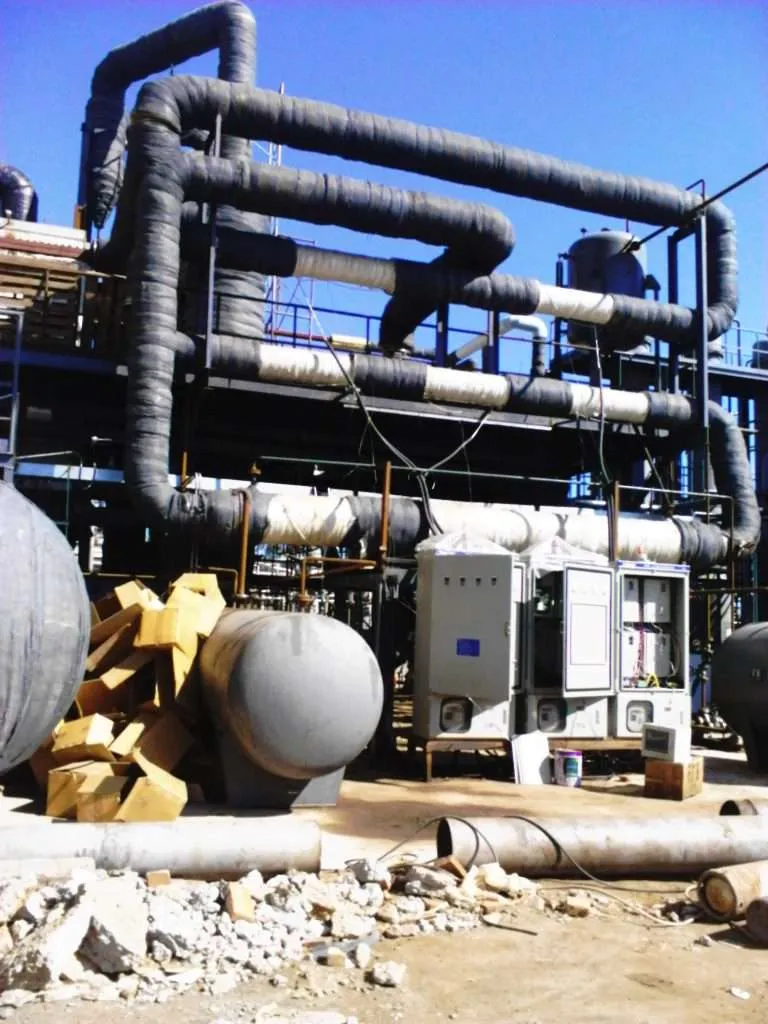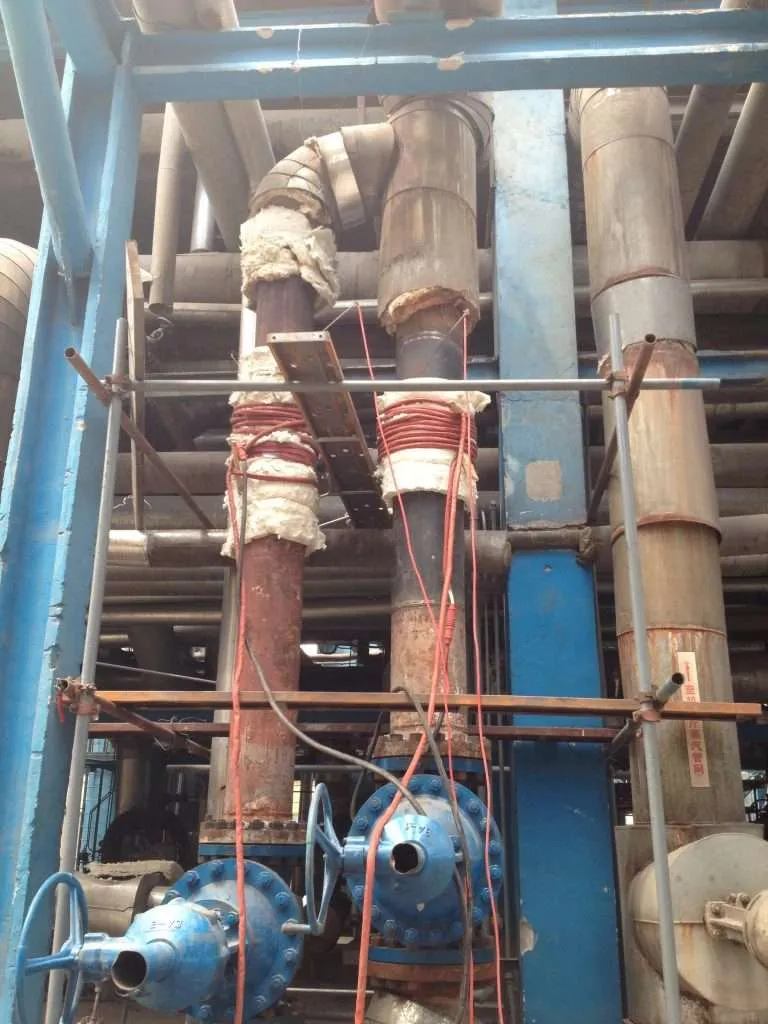
Ensuring Flow Assurance: Induction Heating for Wax and Hydrate Prevention in Oil and Gas Pipelines
Flow assurance is paramount in the oil and gas industry, where the uninterrupted transportation of hydrocarbons through pipelines is essential for operational efficiency and profitability. One of the significant challenges to flow assurance is the formation of wax and hydrates, which can obstruct pipelines and disrupt production. In addressing this challenge, induction heating has emerged as a highly effective and innovative solution.

Understanding the Problem: Wax and Hydrate Formation
Wax and hydrates are natural by-products found in crude oil and natural gas. When transported through pipelines, the temperature of the hydrocarbons can drop below certain thresholds, causing these substances to solidify and adhere to pipeline walls. This buildup gradually restricts flow, leading to reduced throughput and potentially costly operational disruptions.
The Role of Induction Heating
Induction heating technology utilizes electromagnetic induction to generate heat directly within pipeline walls or at critical points where wax and hydrates are likely to form. Unlike traditional methods that involve heating fluids externally or using chemical additives, induction heating offers several distinct advantages:
1. **Precision Heating:** Induction heating allows for precise control over temperature profiles, ensuring that pipeline temperatures remain above the wax appearance temperature (WAT) and hydrate formation temperature thresholds. This targeted approach minimizes energy consumption and maximizes efficiency.
2. **Continuous Monitoring and Control:** Advanced monitoring systems continuously assess pipeline conditions and adjust induction heating parameters in real-time. This proactive management prevents temperature fluctuations that could promote wax and hydrate deposition.
3. **Environmental Sustainability:** Induction heating is inherently cleaner and more environmentally friendly compared to methods involving combustion or chemical treatments. It reduces emissions and minimizes the use of chemicals, aligning with global sustainability goals.
Practical Applications and Benefits
In practice, induction heating systems are strategically deployed along pipelines, particularly in subsea or cold climate regions where temperatures can drop significantly. Key applications include:
- **Subsea Pipelines:** Induction heating protects pipelines operating in deepwater environments where temperatures are conducive to wax and hydrate formation.
- **Arctic and Cold Climate Operations:** Essential for pipelines in regions experiencing extreme cold, where maintaining temperatures above critical thresholds is challenging yet crucial for uninterrupted flow.

Case Studies and Success Stories
Several oil and gas companies have successfully implemented induction heating for wax and hydrate prevention, achieving notable improvements in operational reliability and cost-effectiveness. For instance, in offshore fields where subsea pipelines are subjected to cold seawater temperatures, induction heating has significantly reduced the frequency of pipeline blockages and maintenance shutdowns.
#### Future Directions and Innovations
As technology advances, ongoing research and development are focused on enhancing the efficiency and scalability of induction heating systems. Innovations include improved coil designs for better heat distribution, enhanced monitoring capabilities for predictive maintenance, and integration with smart pipeline management systems.
Here are the detailed steps involved in using induction heating for wax and hydrate prevention:
###
1. Understanding the Problem
Wax and hydrates are natural components found in crude oil and natural gas. When these fluids are transported through pipelines, especially in subsea or cold climate environments, their temperature can drop below critical thresholds. This causes wax to solidify and hydrates to form crystals, leading to the accumulation of deposits along pipeline walls. Over time, these deposits can restrict flow, reduce throughput, and necessitate costly maintenance interventions.
###
2. Designing the Induction Heating System
#### a. System Components:
- **Induction Coils:** Custom-designed coils are wrapped around the pipeline at strategic locations susceptible to wax and hydrate formation. These coils generate electromagnetic fields.
- **Power Supply:** Provides the electrical energy necessary to create the electromagnetic fields in the coils.
- **Control and Monitoring System:** Includes sensors and controllers to monitor pipeline temperature, adjust heating parameters, and ensure precise control over the induction heating process.
#### b. Coil Configuration:
- **Placement:** Coils are positioned along the pipeline where temperature management is critical, such as near wellheads, onshore/offshore risers, or subsea pipeline sections.
- **Size and Shape:** Coils are tailored to fit the diameter and length of the pipeline, ensuring uniform heat distribution and efficient energy transfer.
###
3. Operational Steps
#### a. Heating Strategy:
- **Startup and Warm-Up:** The induction heating system is activated as soon as hydrocarbons start flowing through the pipeline. During startup, the system gradually increases heat to bring the pipeline temperature above the wax appearance temperature (WAT) and hydrate formation temperature.
- **Continuous Heating:** Once operational, the system maintains a consistent pipeline temperature by continuously adjusting the power supplied to the coils based on real-time temperature readings from sensors.
#### b. Monitoring and Control:
- **Temperature Monitoring:** Sensors installed along the pipeline monitor the temperature at multiple points. This data is fed back to the control system, which ensures that the pipeline temperature remains within the optimal range to prevent wax and hydrate deposition.
- **Adjustments and Optimization:** The control system dynamically adjusts heating parameters, such as coil power and frequency, to respond to changes in external conditions (e.g., ambient temperature variations) and internal pipeline conditions (e.g., flow rate fluctuations).

###
4. Benefits and Advantages
#### a. Operational Efficiency:
- **Uninterrupted Flow:** By preventing wax and hydrate buildup, induction heating ensures continuous and efficient transportation of hydrocarbons through the pipeline.
- **Reduced Maintenance:** Minimizes the need for costly and disruptive maintenance interventions, such as pigging operations or chemical treatments to remove deposits.
#### b. Environmental Considerations:
- **Sustainability:** Induction heating is a clean technology that minimizes environmental impact compared to alternative methods, such as chemical inhibitors or combustion-based heating.
- **Energy Efficiency:** Directly heats the pipeline material, reducing energy consumption and optimizing operational costs over the long term.
###
5. Case Studies and Applications
#### a. Offshore Applications:
- **Subsea Pipelines:** Induction heating is particularly crucial for pipelines operating in deepwater environments, where cold seawater temperatures can lead to rapid wax and hydrate formation.
- **Arctic Operations:** In cold climate regions, induction heating systems ensure pipeline integrity and flow assurance despite extreme ambient temperatures.
#### b. Onshore Applications:
- **Pipeline Networks:** Used in onshore pipeline networks to maintain flow assurance across extensive infrastructure, enhancing reliability and reducing downtime.
###
6. Future Developments and Innovations
- **Advanced Materials:** Research continues into developing advanced materials for induction coils and pipeline coatings to further improve heat transfer efficiency and durability.
- **Automation and AI Integration:** Integration with artificial intelligence (AI) algorithms for predictive maintenance and optimized heating strategies based on real-time data analytics.

Conclusion
Induction heating for wax and hydrate prevention represents a technological breakthrough in ensuring flow assurance in oil and gas pipelines. By effectively managing pipeline temperatures above critical thresholds, this method mitigates operational risks, reduces maintenance costs, and supports sustainable energy practices. As industry demands for efficiency and reliability grow, investments in advanced induction heating technologies are poised to play a pivotal role in enhancing pipeline integrity and optimizing hydrocarbon transportation worldwide.
Induction heating represents a transformative approach to ensuring flow assurance in oil and gas pipelines by effectively preventing wax and hydrate formation. Its precision heating capabilities, coupled with environmental benefits and operational efficiencies, make it a preferred choice for industry leaders seeking reliable and sustainable solutions. As the demand for energy continues to grow, investments in technologies like induction heating are pivotal in ensuring the safe and efficient transportation of hydrocarbons while mitigating environmental impacts. Embracing these innovations not only safeguards pipeline integrity but also reinforces the industry's commitment to responsible resource management and operational excellence.
https://dw-inductionheater.com/wax-and-hydrate-prevention-in-oil-and-gas-pipelines-with-induction-heatin.html?feed_id=251061&_unique_id=667819f17b6af



 ### 4. Benefits and Advantages
#### a. Operational Efficiency:
- **Uninterrupted Flow:** By preventing wax and hydrate buildup, induction heating ensures continuous and efficient transportation of hydrocarbons through the pipeline.
- **Reduced Maintenance:** Minimizes the need for costly and disruptive maintenance interventions, such as pigging operations or chemical treatments to remove deposits.
#### b. Environmental Considerations:
- **Sustainability:** Induction heating is a clean technology that minimizes environmental impact compared to alternative methods, such as chemical inhibitors or combustion-based heating.
- **Energy Efficiency:** Directly heats the pipeline material, reducing energy consumption and optimizing operational costs over the long term.
### 5. Case Studies and Applications
#### a. Offshore Applications:
- **Subsea Pipelines:** Induction heating is particularly crucial for pipelines operating in deepwater environments, where cold seawater temperatures can lead to rapid wax and hydrate formation.
- **Arctic Operations:** In cold climate regions, induction heating systems ensure pipeline integrity and flow assurance despite extreme ambient temperatures.
#### b. Onshore Applications:
- **Pipeline Networks:** Used in onshore pipeline networks to maintain flow assurance across extensive infrastructure, enhancing reliability and reducing downtime.
### 6. Future Developments and Innovations
- **Advanced Materials:** Research continues into developing advanced materials for induction coils and pipeline coatings to further improve heat transfer efficiency and durability.
- **Automation and AI Integration:** Integration with artificial intelligence (AI) algorithms for predictive maintenance and optimized heating strategies based on real-time data analytics.
### 4. Benefits and Advantages
#### a. Operational Efficiency:
- **Uninterrupted Flow:** By preventing wax and hydrate buildup, induction heating ensures continuous and efficient transportation of hydrocarbons through the pipeline.
- **Reduced Maintenance:** Minimizes the need for costly and disruptive maintenance interventions, such as pigging operations or chemical treatments to remove deposits.
#### b. Environmental Considerations:
- **Sustainability:** Induction heating is a clean technology that minimizes environmental impact compared to alternative methods, such as chemical inhibitors or combustion-based heating.
- **Energy Efficiency:** Directly heats the pipeline material, reducing energy consumption and optimizing operational costs over the long term.
### 5. Case Studies and Applications
#### a. Offshore Applications:
- **Subsea Pipelines:** Induction heating is particularly crucial for pipelines operating in deepwater environments, where cold seawater temperatures can lead to rapid wax and hydrate formation.
- **Arctic Operations:** In cold climate regions, induction heating systems ensure pipeline integrity and flow assurance despite extreme ambient temperatures.
#### b. Onshore Applications:
- **Pipeline Networks:** Used in onshore pipeline networks to maintain flow assurance across extensive infrastructure, enhancing reliability and reducing downtime.
### 6. Future Developments and Innovations
- **Advanced Materials:** Research continues into developing advanced materials for induction coils and pipeline coatings to further improve heat transfer efficiency and durability.
- **Automation and AI Integration:** Integration with artificial intelligence (AI) algorithms for predictive maintenance and optimized heating strategies based on real-time data analytics.

